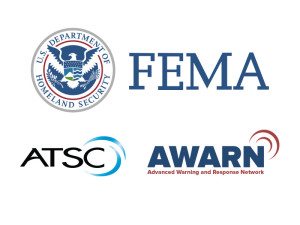- About
- Members
- Sponsors
- Subcommittees
- Technical Documents
- News
- Events
- Spotlight ATSC 3.0
- Contact Us
- Member Login
- Member Meetings
- Advanced Search
Search Site
Member Links
- About
- Members
- Sponsors
- Subcommittees
- Technical Documents
- News
- Events
- Spotlight ATSC 3.0
- Contact Us
- Member Login
- Member Meetings
- Advanced Search
FEMA Lab to Assess Advanced Emergency Alerting Technology
Posted on November 3, 2015 in ATSC News
 Life-Saving Technology Will Leverage ATSC 3.0 Standard
Life-Saving Technology Will Leverage ATSC 3.0 Standard
In anticipation of next-generation broadcasting with ATSC 3.0, the Federal Emergency Management Agency (FEMA) is assessing the feasibility of advanced new broadcast public alert and warning technology, the U.S. Department of Homeland Security announced.
ATSC Advanced Emergency Alerting will leverage the new capabilities inherent in ATSC 3.0 to deliver rich media alerts. One implementation, called the Advanced Warning and Response Network (AWARN), is designed to transmit video, photographs, text, evacuation routes, maps, plume models, radar images, html pages, shelter information, Amber Alerts and more. The use of Internet Protocol technology with ATSC 3.0 will allow this new application to fully integrate with other IP networks, including those used for emergency communications.
Under its National Continuity Programs, FEMA is gathering data and assessing the capabilities of ATSC 3.0 Advanced Emergency Alerting at its test lab for IPAWS, the U.S. Integrated Public Alert and Warning System. The lab intends to determine how effectively the future technologies like the AWARN broadcast system can work within the IPAWS alerting infrastructure.
“FEMA is committed to working with the private sector to examine and improve future alerts and warnings,” said Roger Stone, Acting Assistant Administrator for National Continuity Programs. “New systems could someday include pictures and video as part of the advanced alert and warning information provided to the general public.”
Testing at the IPAWS Lab at the Joint Interoperability Test Command in Indian Head, Md., ultimately will demonstrate the feasibility and operational deployment of AWARN within the IPAWS suite of technologies and allow public safety officials to gain confidence using IPAWS in a secure environment, according to FEMA.
AWARN’s equipment will be put through its paces at the IPAWS Lab, where closed-environment testing will be employed to assess its capabilities. Initial FEMA testing with first-generation M-EAS technology lays the groundwork for further testing of the very robust advanced alerting system as the ATSC 3.0 standards process proceeds over the next year. Just as with Mobile EAS using the current ATSC standard
Posted in ATSC News
News Categories
News Archives
Subscribe
Subscribe to The Standard, our monthly newsletter. Learn More
Join ATSC
ATSC is a membership organization with both voting and observer categories. Voting members include corporations, nonprofit organizations, and government entities, and they participate actively in the work of ATSC. Observers are individuals or entities not eligible to be a voting member.
Subscribe to our Newsletter
Subscribe to The Standard, our monthly newsletter, to stay up-to-date with ATSC news and events around the world.
Site Links
Contact Us
ATSC
1300 I Street NW, Suite 400E
Washington, DC 20005 USA
Do you have questions about ATSC?
About ATSC
ATSC, the Broadcast Standards Association, is an international, non-profit organization developing voluntary standards and recommended practices for digital terrestrial broadcasting. Serving as an essential force in the broadcasting industry, ATSC guides the seamless integration of broadcast and telecom standards to drive the industry forward. Currently, the ATSC 3.0 Standard is providing the best possible solution for expanding the potential of the broadcast spectrum beyond its traditional application to meet changing needs. From conventional television to innovative digital data services, ATSC has one clear goal: to empower the broadcasting ecosystem like never before.
© 2025 ATSC




































